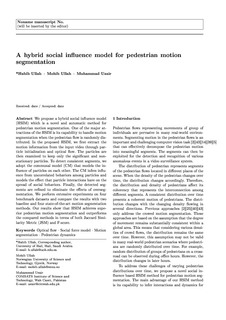A hybrid social influence model for pedestrian motion segmentation
Journal article, Peer reviewed
Accepted version

Åpne
Permanent lenke
http://hdl.handle.net/11250/2594365Utgivelsesdato
2018Metadata
Vis full innførselSamlinger
Sammendrag
A hybrid social influence model (HSIM) has been proposed which is a novel and automatic method for pedestrian motion segmentation. One of the major attractions of the HSIM is its capability to handle motion segmentation when the pedestrian flow is randomly distributed. In the proposed HSIM, first the motion information has been extracted from the input video through particle initialization and optical flow. The particles are then examined to keep only the significant and nonstationary particles. To detect consistent segments, the communal model (CM) is adopted that models the influence of particles on each other. The CM infers influence from uncorrelated behaviors among particles and models the effect that particle interactions have on the spread of social behaviors. Finally, the detected segments are refined to eliminate the effects of oversegmentation. Extensive experiments on four benchmark datasets have been performed, and the results have been compared with two baseline and four state-of-the-art motion segmentation methods. The results show that HSIM achieves superior pedestrian motion segmentation and outperforms the compared methods in terms of both Jaccard Similarity Metric and F-score.